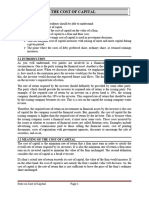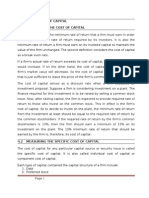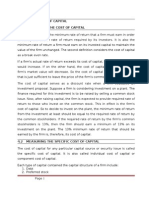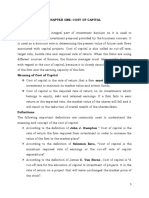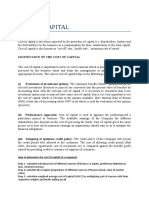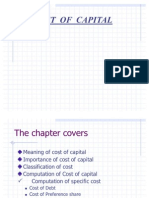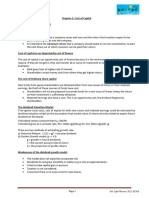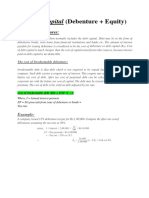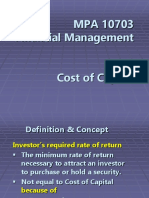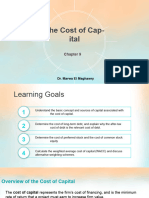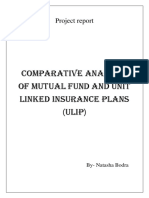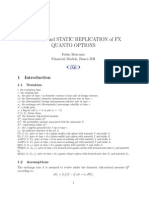The Cost of Capital
The Cost of Capital
Uploaded by
Benol MekonnenCopyright:
Available Formats
The Cost of Capital
The Cost of Capital
Uploaded by
Benol MekonnenOriginal Description:
Original Title
Copyright
Available Formats
Share this document
Did you find this document useful?
Is this content inappropriate?
Copyright:
Available Formats
The Cost of Capital
The Cost of Capital
Uploaded by
Benol MekonnenCopyright:
Available Formats
CHAPTER -3
COST OF CAPITAL
3. The Cost of Capital
3.1. Introduction
As you well understand, two parties are involved in a financial asset under normal
circumstances. One is the party issuing the financial asset. Another is the one that buys or invests
on the financial asset. The rate of return required by the investor should definitely be provided
by some other party. The party which should provide the investor its required rate of return is the
issuing party. For example, if the required rate of return by an investor on a given bond is 10%,
the issuing company should provide this 10% to the investor. This required rate of return that
should be met by the issuing company becomes its cost.
This is a cost on the capital the issuing company wants to raise. Therefore, the required rate of
return on investments in financial assets by the investor is the cost of capital for the company
issued the financial assets. But, generally, the cost of capital for the issuing company is higher
than the required rate of return by the investor. This is because when the issuing company issues
a financial asset, it must incur some costs. These costs incurred by the issuer in relation to
issuance of financial assets are called flotation costs. Examples include advertising costs,
commissions paid to those selling the financial assets, cost of printing documents, costs of
registration with government agencies, discounts to encourage the sale of securities, and so on.
3.2. Meaning of the Cost of Capital
The cost of capital is the minimum rate of return that a firm must earn in order to satisfy the
overall rate of return required by its investors. It is also the minimum rate of return a firm must
earn on its invested capital to maintain the value of the firm unchanged. The second definition
considers the cost of capital as a break even rate.
If a firm’s actual rate of return exceeds its cost of capital, the value of the firm would increase. If
on the other hand, the cost of capital is not earned, the firm’s market value will decrease. So the
cost of capital is the rate of return that is just sufficient to leave the price of the firm’s common
stock unchanged.
The cost of capital serves as a discount rate when a firm evaluates an investment proposal.
Suppose a firm is considering investment on a plant. The finance required for this investment is
to be raised by selling a common stock issue. Now, after raising capital, the firm is expected to
provide required rate of return to those who invest on the common stock. This in effect is the
firm’s cost of capital. So to decide to invest on the plant, the minimum rate of return from the
investment at least should be equal to the required rate of return by the common stockholders.
If the required rate of return by the firm’s common stockholders is 13%, then the firm should
earn a minimum of 13% on its investment on the plant. The 13% minimum rate of return that
should be earned by the firm is, therefore, its cost of capital.
Compiled by Benol.M Page 1
CHAPTER -3
COST OF CAPITAL
3.3. Measuring the specific cost of capital
The cost of capital for any particular capital source or security issue is called the specific cost of
capital. It is also called individual cost of capital or component cost of capital.
Each type of capital contained the capital structure of a firm include:
1. Debt
2. Preferred stock
3. Common stock
4. Retained earnings
Two important points you should bear in mind about the specific cost of capital. One is that it is
computed on an after-tax basis. Meaning, if there would be any tax implication on the individual
source of capital, it should be considered. In almost all circumstances, the tax implication is only
on debt sources of finance. The second point is that the specific cost of capital is expressed as an
annual percentage or rate like 6%, 9%, or 10%. The cost of capital is not stated in terms of birr.
3.3.1. The cost of debt
This is the minimum rate of return required by suppliers of debt. The relevant specific cost of
debt is the after-tax cost of new debt. Generally, debt is the cheapest source of finance to a firm
and, hence, the cost of debt is the lowest specific cost of capital. There are two basic
explanations for this. First, debt suppliers, generally, assume the lowest risk among all supplier
of capital. They receive interest payments before preferred and common dividends are paid.
Since they assume the smallest risk, their return is the lowest. Their lowest return would be the
lowest cost of capital to the firm. Second, raising capital through debt sources entails interest
expense. The interest expense in turn reduces the firm’s income which ultimately would cause
tax payment to be reduced. So raising money in the form of debt results in the smallest tax
burden, and finally, the firm’s cost of debt would be the lowest.
Debt sources of finance may take several forms like bonds, promissory notes, bank loans. Here,
for our convenience we consider bond issue to illustrate the cost of debt.
Computing the cost of new bond issue involves three steps:
i) Determine the net proceeds from the sale of each bond
NPd = P – f
Where:
NPd = The net proceeds from the sale of each bond
P = The market price of the bond
f = Flotation costs
ii) Compute the effective before tax cost of the bond using the following approximation formula:
Pn NPd
I
Kd = n
Pn NPd
2
Compiled by Benol.M Page 2
CHAPTER -3
COST OF CAPITAL
Where:
Kd = The effective before tax cost of debt
I = Annual interest payment
Pn = The par value of the bond
n = Length of the holding period of the bond in years.
iii) Compute the after-tax cost of debt
Kdt = Kd (1 – t)
Where:
Kdt = The after-tax cost of debt
t = The marginal tax rate
Example: Currently, Bontu Industrial Group is planning to sell 15-year, Br. 1,000 par-value
bonds that carry a 12% annual coupon interest rate. As a result of lower current interest rates,
Abyssinia bonds can be sold for Br. 1,010 each. Flotation costs of Br. 30 per bond will be
incurred in the process of issuing the bonds. The firm’s marginal tax rate is 40%.
Required: Calculate the after tax cost of Abyssinia’s new bond issue:
Solution:
Given:Pn = Br. 1,000; I = Br. 120 (Br. 1,000 x 12%); n = 15; Pd = Br. 1,010; f = Br. 30;
t = 40%; Kdt=?
Then apply the three steps:
i) NPd = Br. 1,010 – Br. 30 = Br. 980
Br.1,000 Br.980
Br.120
ii) Kd = 15 12.26%
Br.1,000 Br.980
2
iii) Kdt = 12.26% (1 – 40%) = 7.36%
Therefore, the after – tax cost of Abyssinia’s new bond issue is 7.36%. That is, Abyssinia should
be able to earn a minimum of 7.36% to satisfy bondholders. Otherwise, the firm’s value will
decline.
3.3.2. The cost of preferred stock
The cost of preferred stock is the minimum rate of return a firm must earn in order to satisfy the
required rate of return of the firm’s preferred stock investors. It is also the minimum rate of
return a firm’s preferred stock investors require if they are to purchase the firm’s preferred stock.
When a firm raises capital by issuing new preferred stock, it is expected to pay fixed amount of
dividends to the preferred stockholders. So it is the dividend payment that is the cost of the
preferred stock to the firm stated as an annual rate.
Compiled by Benol.M Page 3
CHAPTER -3
COST OF CAPITAL
The cost of a new preferred stock issue can be computed by following two steps:
i) Determine the net proceeds from the sale of each preferred stock.
NPpf = Ppf – f
Where:
NPpf = Net proceeds from the sale of each preferred stock
Ppf = Market price of the preferred stock
f = Flotation costs
ii) Compute the cost of preferred stock issue
Kps = Dps__
NPpf
Where:
Kps = The cost of preferred stock
DPs = The pre share annual dividend on the preferred stock
Example:Woma ComputerSystems Company has just issued preferred stock. The stock has 12%
annual dividend and Br. 100 par value and was sold at 102% of the par value. In addition,
flotation costs of Br. 2.50 per share must be paid. Calculate the cost of the preferred stock.
Solution:
Given: Pps = Br. 102 (Br. 100 x 102%); Dps = Br. 12 (Br 100 x 12%); f = Br. 2.50;
Kps =?
Then apply the two steps:
i) NPpf = Br. 102 – Br. 2.50 = Br. 99.50
ii) Kps = Br. 12 =12.06%
Br. 99.50
Therefore, Woma Company should be able to earn a minimum of 12.06% on any investment
financed by the new preferred stock issue. Otherwise, the firm’s value will decrease.
3.3.3. The cost of common stock
The cost of common stock is the minimum rate of return that a firm must earn for its common
stockholders in order to maintain the value of the firm. A firm does not make explicit
commitment to pay dividends to common stockholders. However, when common stockholders
invest their money in a corporation, they expect returns in the form of dividends. Therefore,
common stocks implicitly involve a return in terms of the dividends expected by investors and
hence, they carry cost.
Generally, common stock dividends are paid after interest and preferred dividends are paid. As a
result, common stock investors assume the maximum risk in corporate investment.
They compensate the maximum risk by requiring the highest return. This highest return expected
by common stockholders make common stock the most expensive source of capital.
Compiled by Benol.M Page 4
CHAPTER -3
COST OF CAPITAL
The cost of common stock can be computed using the constant growth valuation model.
Ks = D1+ g
NPo
Where:
Ks = The cost of new common stock issue
D1 = The expected dividend payment at the end of next year
NPo = Net proceeds from the sale of each common stock
g = The expected annual dividends growth rate
The net proceeds from the sale of each common stock (NPo) is computed as follows:
NPo = Po – f
Where:
Po = The current market price of the common stock
f = flotation costs
Example: An issue of common stock is sold to investors for Br. 20 per share. The issuing
corporation incurs a selling expense of Br. 1 per share. The current dividend is Br. 1.50 per share
and it is expected to grow at 6% annual rate. Compute the specific cost of this common stock
issue.
Solution
Given: Po = Br. 20; Do = Br. 1.50; g = 6%; f = Br. 1; Ks =?
Then apply the two steps:
i) NPo = Br. 20 – Br. 1 = Br. 19
ii) Ks = D1 + g = Br. 1.50 (1.06) = 14.37%
Npo Br. 19
Therefore, the firm should be able to earn a minimum return of 14.37% on investments that are
financed by the new common stock issue.
3.3.4. The Cost of Retained Earnings
Retained earnings represent profits available for common stockholders that the corporation
chooses to reinvest in itself rather than payout as dividends. Retained earnings are not securities
like stocks and bonds and hence do not have market price that can be used to compute costs of
capital.
The cost of retained earnings is the rate of return a corporation’s common stockholders expect
the corporation to earn on their reinvested earnings, at least equal to the rate earned on the
outstanding common stock. Therefore, the specific cost of capital of retained earnings is equated
with the specific cost of common stock. However, flotation costs are not involved in the case of
retained earnings.
Compiled by Benol.M Page 5
CHAPTER -3
COST OF CAPITAL
Computing the cost of retained earnings involves just a single procedure of applying the
following formula:
Kr = D1 + g
Po
Where:
Kr = The cost of retained earnings
D1 = The expected dividends payment at the end of next year
Po = The current market price of the firm’s common stock
g = The expected annual dividend growth rate.
Example: Lega tafo Auto Spare Parts Manufacturing company expects to pay a common stock
dividend of Br. 2.50 per share during the next 12 months. The firm’s current common stock price
is Br. 50 per share and the expected dividend growth rate is 7%. A flotation cost of Br. 3 is
involved to sale a share of common stock.
Required: Compute the cost of retained earnings
Solution
Given: Po = Br. 50; D1 = Br. 2.50; g = 7%; Kr = ?
Then apply the formula:
Kr = D1+ g = Br. 2.50 + 7% = 12%
Po Br. 50
3.4. Weighted Average Cost of Capital (WACC)
In the previous section we have seen how to compute the cost of capital for each individual
source of capital. The specific cost of capital is used in evaluating an investment proposal to be
financed by a particular capital source. Practically, however, investment are financed by two or
more sources of capital. In such a situation, we cannot make use of the individual cost of capital.
Rather we should use the average cost of capital employed by the firm. The firm’s capital
structure is composed of debt, preferred stock, common stock, and retained earnings. Each
capital source accounts to some portion of the total finance. But the percentage contribution of
one source is usually different from another. So we must compute the weighted average cost of
capital rather than the simple average.
The weighted average cost of capital (WACC) is the weighted average of the individual costs of
debt, preferred stock and common equity (common stock and retained earnings). It is also called
the composite cost of capital.
Compiled by Benol.M Page 6
CHAPTER -3
COST OF CAPITAL
If the weights of the component capital sources are all given, the weighted average cost of capital
can be computed as:
WACC = WdKdt + WpsKps + WceKs
Where:
WACC = The weighted average cost of capital
Wd = The weight of debt
Wps = The weight of preferred stock
Wce = The weight of common equity
Kdt = The after – tax cost of debt
Kps = The cost of preferred stock
Ks = The cost of common equity
The WACC is found by weighting the cost of each specific type of capital by its proportion in
the firm’s capital structure. Weights of the individual capital sources can be calculated based on
their book value or market value.
To illustrate the computation of the WACC, look at the following example.
Muna Tools Manufacturing Company’s financial manager wants to compute the firm’s weighted
average cost of capital. The book and market values of the amounts as well as specific after-tax
costs are shown in the following table for each source of capital.
Source of capital Book value Market value Specific cost
Debt Br. 1,050,000 Br. 1,000,000 5.3%
Preferred stock 84,000 125,000 12.0
Common equity 966,000 1,375,000 16.0
Total Br. 2,100,000 Br. 2,500,000
Required: Calculate the firm’s weighted average cost of capital using:
1) book value weights
2) market value weights
Solution:
1) Total book value = Br. 2,100,000
Wd = Br. 1,050,000 = 0.5; Wps = Br. 84,000__ = 0.04; Wce = Br. 966,000 = 0.46
Br. 2,100,000 Br. 2,100,000 Br. 2,100,000
WACC = WdKdt + WpsKps + WceKs
= 0.5 (5.3%) + 0.04 (12.0%) + 0.46 (16.0%)
= 2.65% + 0.48% + 7.36%
= 10.49%
Compiled by Benol.M Page 7
CHAPTER -3
COST OF CAPITAL
The minimum rate of return on all projects should be 10.49%. Meaning, Muna should accept all
projects so long as they earn a return greater than or equal to 10.49%
2) Total Market value = Br. 2,500,000
Wd = Br. 1,000,000 = 0.4; Wps = Br. 125,000 = 0.05; Wce = Br. 1,375,000 = 0.55
Br. 2,500,000 Br. 2,500,000 Br. 2,500,000
WACC = 0.4 (5.3%) + 0.05 (12.0%) + 0.55 (16.0%)
= 2.12% + 0.60% + 8.80%
= 11.52%
If the market value weights are used, Muna should accept all projects with a minimum rate of
return of 11.52%
3.5. The Marginal Cost of Capital (MCC)
As a firm tries to have more new capital, the cost of each birr will rise at some point. Thus, the
marginal cost of capital (MCC) is the cost of obtaining additional new capital. Technically
speaking, the MCC is the weighted average cost of the last birr of new capital obtained. So the
concept of marginal cost of capital is discussed in the context of the weighted average cost of
capital.
As a firm raises larger and larger amounts of capital, the weighted average cost of capital also
rises. But the question would be at what point the firm’s costs of debt, preferred stock, and
common equity as well as WACC increase?
The first point, therefore, in computing the MCC is to determine the breaking points where the
cost of capital will increase.
The technical aspects of the MCC can be better understood using an example.
Example: The target capital structure of ABC Corporation and other pertinent data are given
below.
Long-term debt ------------------ 40%; cost of preferred stock (Kps) = 12.06%
Preferred stock -------------------10% cost of retained earnings (Kr) = 14%
Common equity ----------------- 50% cost of common stock (Ks) = 15%
ABC Corporation has Br. 900,000 available retained earnings. But when the firm fully utilizes its
retained earnings, it must use the more expensive new common stock financing to meet its equity
needs. In addition, the firm expects that it can borrow up to Br. 1,200,000 of debt at 7.3% after-
tax cost. Additional debt will have an after-tax cost of 9.1%.
Required
1) What is the breaking point associated with the
a. Exhausting of retained earnings?
b. Increment of debt between Br. 0 to Br. 1,200,000?
2) Determine the ranges of total new financing where the WACC will rise
3) Calculate the WACC for each range of finance.
Compiled by Benol.M Page 8
CHAPTER -3
COST OF CAPITAL
Solutions
1) a. Breaking point (BP) common equity = Br. 900,000 = Br. 1,800,000
50%
b. Breaking point (BP) long-term debt = Br. 1,200,000 = Br. 3,000,000
40%
The breaking points computed above can be interpreted as:
ABC can meet its equity needs using retained earnings until its total finance need is Br.
1,800,000.
But when total capital required is more than Br. 1,800,000, its equity needs should be met with
common stock. Similarly, until the firm’s total finance need reaches Br. 3,000,000, ABC can
raise any debt at 7.3% cost. Any further finance need beyond Br. 3,000,000 will cause the cost of
debt to rise to 9.1%.
2) There are three ranges of finance that could be identified on the basis of the breaking points:
1stRange : Br. 0 to Br. 1,800,000,
2ndRange : Br. 1,800,000 to Br. 3,000,000, and
3rdRange : Br. 3,000,000 and above
3) WACC (1st range) = 0.40 (7.3%) + 0.10 (12.06%) + 0.50 (14%)
= 2.92% + 1.21% + 7.00%
= 11.13%
nd
WACC (2 range) = 0.40 (7.3%) + 0.10 (12.06%) + 0.50 (15%)
= 2.92% + 1.21% + 7.50%
= 11.63%
rd
WACC (3 range) = 0.40 (9.1%) + 0.10 (12.06%) + 0.50 (15%)
= 3.64% + 1.21% + 7.50%
= 12.35%
Compiled by Benol.M Page 9
You might also like
- Sbi FD PDFDocument1 pageSbi FD PDFAnonymous vlChJNcFJ450% (2)
- IMT CDL Finance - All Questions & AnswersDocument12 pagesIMT CDL Finance - All Questions & AnswersPranav Sharma33% (3)
- FAR MockBoard (NFJPIA) - 2017Document9 pagesFAR MockBoard (NFJPIA) - 2017ken100% (1)
- 2015@FM I CH 5-Cost of CapitalDocument9 pages2015@FM I CH 5-Cost of CapitalALEMU TADESSENo ratings yet
- FM Chapter 3.new-1Document11 pagesFM Chapter 3.new-1Terefe DubeNo ratings yet
- Chapter 3Document13 pagesChapter 3Ebsa AbdiNo ratings yet
- Fm-i Chap 4, 5 & 6Document34 pagesFm-i Chap 4, 5 & 6margera158No ratings yet
- UU FM-I - Chapter 6 CCDocument8 pagesUU FM-I - Chapter 6 CCNahomNo ratings yet
- Chapter Five Cost of CapitalDocument14 pagesChapter Five Cost of CapitalAbdimalik NaxarNo ratings yet
- Chapter Four The Cost of CapitalDocument26 pagesChapter Four The Cost of CapitalLetaNo ratings yet
- Financial Management Chapter 03 FMDocument13 pagesFinancial Management Chapter 03 FMbikilahussenNo ratings yet
- Cost of CapitalDocument12 pagesCost of CapitalAbdii DhufeeraNo ratings yet
- Unit 4: The Cost of Capital 4.1 Meaning of The Cost of CapitalDocument12 pagesUnit 4: The Cost of Capital 4.1 Meaning of The Cost of CapitalAbdii DhufeeraNo ratings yet
- FM CH 3Document18 pagesFM CH 3samuel kebedeNo ratings yet
- Chapter 1Document28 pagesChapter 140 Spring Tube100% (1)
- CH-3 Advanced Financial MGTDocument53 pagesCH-3 Advanced Financial MGTMusxii TemamNo ratings yet
- Chapter 3Document18 pagesChapter 3Tasebe GetachewNo ratings yet
- CHAPTER 5: Cost of CapitalDocument27 pagesCHAPTER 5: Cost of Capitalgirma guddeNo ratings yet
- FM I Chapter 5Document11 pagesFM I Chapter 5mearghaile4No ratings yet
- CHAPTER Three HandoutDocument17 pagesCHAPTER Three HandoutNati AlexNo ratings yet
- Chapter Seven Sources Aand Cost of Project FinanceDocument11 pagesChapter Seven Sources Aand Cost of Project FinanceMahamoud HassenNo ratings yet
- David Corporate AssignmentDocument13 pagesDavid Corporate Assignmentsamuel debebeNo ratings yet
- Concept and Significance of Cost of Capital and Its ComputationDocument24 pagesConcept and Significance of Cost of Capital and Its ComputationManali OjhaNo ratings yet
- FM I CH 5 EditedDocument20 pagesFM I CH 5 EditedDaniel BalchaNo ratings yet
- FM Chapter Three-1Document10 pagesFM Chapter Three-1metadelaschale64No ratings yet
- Cost of CapitalDocument99 pagesCost of CapitalRajesh GovardhanNo ratings yet
- Calcul Ating T He Co ST O F CapitalDocument50 pagesCalcul Ating T He Co ST O F CapitalSyrell NaborNo ratings yet
- Chapter Four: The Cost of Capital 4.1. The Concept of Cost of CapitalDocument9 pagesChapter Four: The Cost of Capital 4.1. The Concept of Cost of Capitalmelat felekeNo ratings yet
- By: CA Kapileshwar Bhalla: Paper 3A: Cost Accounting Chapter 4 Unit-IDocument65 pagesBy: CA Kapileshwar Bhalla: Paper 3A: Cost Accounting Chapter 4 Unit-IabcdNo ratings yet
- Cost of CapitalDocument55 pagesCost of CapitalSaritasaruNo ratings yet
- Content 2 PDFDocument13 pagesContent 2 PDFSecurity Bank Personal LoansNo ratings yet
- Cost of Capital Term Paper FullDocument12 pagesCost of Capital Term Paper FullAzizul AviNo ratings yet
- Unit 2 Cost of CapitalDocument16 pagesUnit 2 Cost of CapitalFalguni ChaudhariNo ratings yet
- Cost of Capital 2022Document12 pagesCost of Capital 2022hitisha agrawalNo ratings yet
- Cost of CapitalDocument26 pagesCost of CapitalRajesh ShresthaNo ratings yet
- Ch6 EDocument39 pagesCh6 Ehuy anh leNo ratings yet
- Costcap - BestDocument13 pagesCostcap - BestMuhammad ZubairNo ratings yet
- Chapter 1Document19 pagesChapter 1chaman_shresthaNo ratings yet
- Cost of CapitalDocument44 pagesCost of CapitalSubia Hasan50% (4)
- Chapter-5 - Cost of CapitalDocument5 pagesChapter-5 - Cost of Capitalsabbir AhmedNo ratings yet
- Cost of Debenture & Equity (With Numerical - Corporate Finance)Document10 pagesCost of Debenture & Equity (With Numerical - Corporate Finance)fatimafirdaus147No ratings yet
- Module 3fjgjbbnzbvbksvjabvdhnbjdbksbnDocument18 pagesModule 3fjgjbbnzbvbksvjabvdhnbjdbksbnizhseabt2fNo ratings yet
- The Cost of Capital: Elvira E. OngyDocument41 pagesThe Cost of Capital: Elvira E. OngyrakeshkchouhanNo ratings yet
- Copy (3) of Mani FinanceDocument13 pagesCopy (3) of Mani FinancetapasyaferiaNo ratings yet
- Cost CapitalDocument36 pagesCost CapitalOlivier MNo ratings yet
- Ing. Tomáš Rábek, PHD Department of FinanceDocument24 pagesIng. Tomáš Rábek, PHD Department of FinancefendyNo ratings yet
- Cost of CapitalDocument11 pagesCost of CapitalJOHN PAOLO EVORANo ratings yet
- MPA 10703 Financial Management Cost of CapitalDocument40 pagesMPA 10703 Financial Management Cost of CapitalMaryam BielaNo ratings yet
- Cost of CapitalDocument42 pagesCost of CapitalimasikudenisiahNo ratings yet
- Cost of Capital (Updated)Document21 pagesCost of Capital (Updated)Asmaa AlsabaaNo ratings yet
- Cost of CapitalDocument46 pagesCost of CapitalJOEL ALUOCHNo ratings yet
- Capital Structure and Cost of CapitalDocument33 pagesCapital Structure and Cost of CapitaljescataryNo ratings yet
- Cost of Capital: Concept and ComputationDocument40 pagesCost of Capital: Concept and ComputationPrateek AroraNo ratings yet
- Cost of CapitalDocument6 pagesCost of CapitalsmarkmostafizNo ratings yet
- AFM Unit 2Document19 pagesAFM Unit 2Naveen NNo ratings yet
- FM Cost of CapitalDocument4 pagesFM Cost of CapitalSuraj AgarwalNo ratings yet
- TOPIC 7 Cost of CapitalDocument47 pagesTOPIC 7 Cost of CapitalAlyana LinogNo ratings yet
- Chapter 3 Cost of CapitalDocument30 pagesChapter 3 Cost of CapitalMELAT ROBELNo ratings yet
- BIAYA MODAL CompressedDocument89 pagesBIAYA MODAL CompressedMuh IdhamsyahNo ratings yet
- FM - Chapter 9Document5 pagesFM - Chapter 9sam989898No ratings yet
- Chapter 3: Interest Rates and Security ValuationDocument53 pagesChapter 3: Interest Rates and Security ValuationhothaifaabusaleemNo ratings yet
- CPA Review Notes 2019 - BEC (Business Environment Concepts)From EverandCPA Review Notes 2019 - BEC (Business Environment Concepts)Rating: 4 out of 5 stars4/5 (9)
- Ifa Ii CH 1Document32 pagesIfa Ii CH 1Benol MekonnenNo ratings yet
- Afa-Ii CH-1Document10 pagesAfa-Ii CH-1Benol MekonnenNo ratings yet
- Afa-Ii CH-3Document38 pagesAfa-Ii CH-3Benol MekonnenNo ratings yet
- Chapter 2management TheoriesDocument169 pagesChapter 2management TheoriesBenol MekonnenNo ratings yet
- Afa-Ii CH-4Document45 pagesAfa-Ii CH-4Benol Mekonnen100% (1)
- Chapter Four Receivables Management Nature and Importance of ReceivablesDocument10 pagesChapter Four Receivables Management Nature and Importance of ReceivablesBenol MekonnenNo ratings yet
- Afa-Ii CH-1Document35 pagesAfa-Ii CH-1Benol MekonnenNo ratings yet
- Chapter Four Capital Budgeting/Investment DecisionDocument10 pagesChapter Four Capital Budgeting/Investment DecisionBenol MekonnenNo ratings yet
- Financial Management I: 2. Financial Analyses and PlanningDocument8 pagesFinancial Management I: 2. Financial Analyses and PlanningBenol MekonnenNo ratings yet
- Fm-Ii CH-2Document11 pagesFm-Ii CH-2Benol MekonnenNo ratings yet
- Rift Valley University Lega Tafo Campus Department of Buma Financial ManagementDocument10 pagesRift Valley University Lega Tafo Campus Department of Buma Financial ManagementBenol MekonnenNo ratings yet
- Cma-Ii CH-4Document19 pagesCma-Ii CH-4Benol MekonnenNo ratings yet
- AIS Chapter OneDocument12 pagesAIS Chapter OneBenol MekonnenNo ratings yet
- Cma-Ch 5Document17 pagesCma-Ch 5Benol MekonnenNo ratings yet
- Chapter 2 Master BudetDocument16 pagesChapter 2 Master BudetBenol MekonnenNo ratings yet
- Cma-Ii CH-3Document11 pagesCma-Ii CH-3Benol MekonnenNo ratings yet
- Chapter 1 CVP AnalysisDocument8 pagesChapter 1 CVP AnalysisBenol MekonnenNo ratings yet
- Chapter 1 TheoryDocument14 pagesChapter 1 TheoryCrissa Mae FalsisNo ratings yet
- Financial Statement Analysis - (MODULE 2 FUNDAMENTALS OF FINANCIAL STATEMENT ANALYSIS) PDFDocument114 pagesFinancial Statement Analysis - (MODULE 2 FUNDAMENTALS OF FINANCIAL STATEMENT ANALYSIS) PDFAnonymous RNjuHor100% (2)
- Behavioural FinanceDocument14 pagesBehavioural FinanceRadhakrishna MishraNo ratings yet
- FX Insifddggfght e PDFDocument16 pagesFX Insifddggfght e PDFPopeye AlexNo ratings yet
- A - Comparative - Analysis - of - Mutual Funds & ULIPDocument68 pagesA - Comparative - Analysis - of - Mutual Funds & ULIPNatasha BodraNo ratings yet
- Bac2664auditing l10 2 Non Current AssetsDocument7 pagesBac2664auditing l10 2 Non Current AssetssueernNo ratings yet
- Beacon Pharmaceuticals LTD.: ParticularsDocument6 pagesBeacon Pharmaceuticals LTD.: ParticularsNur Md Al HossainNo ratings yet
- Pricing and Static Replication of FX Quanto Options: Fabio Mercurio Financial Models, Banca IMIDocument5 pagesPricing and Static Replication of FX Quanto Options: Fabio Mercurio Financial Models, Banca IMISteven WheeldonNo ratings yet
- Alliance BankDocument5 pagesAlliance Bankbekza_159No ratings yet
- How To Value Employee Stock Options: John Hull and Alan WhiteDocument6 pagesHow To Value Employee Stock Options: John Hull and Alan WhiteYeak Chee KeongNo ratings yet
- Option Chain (Equity Derivatives)Document3 pagesOption Chain (Equity Derivatives)RJ LaxmikaantNo ratings yet
- 12th Commerce Important QuestionsDocument4 pages12th Commerce Important QuestionsNaveenNo ratings yet
- Eugenio V Drilon Jan 22 1996 G.R. No. 109404Document3 pagesEugenio V Drilon Jan 22 1996 G.R. No. 109404elleNo ratings yet
- Topic 3 - Financial Instruments - IfRSDocument29 pagesTopic 3 - Financial Instruments - IfRSLinh HoangNo ratings yet
- Business Guardian (New Delhi) - May 23, 2023Document8 pagesBusiness Guardian (New Delhi) - May 23, 2023Camilo BenavidesNo ratings yet
- Full Report (FSA)Document29 pagesFull Report (FSA)Danny Yong Seng Ee100% (1)
- PWC Using Multiple Discount Rates BulletinDocument4 pagesPWC Using Multiple Discount Rates BulletinElizabeth KrusemarkNo ratings yet
- 4 - Kinds of CompaniesDocument7 pages4 - Kinds of CompaniesSahil25% (4)
- Corporate GovernanceDocument43 pagesCorporate Governancem_dattaias100% (1)
- Kazakhstan Institute of ManagementDocument8 pagesKazakhstan Institute of Managementbekza_159No ratings yet
- BlueDart Express - Initiating CoverageDocument24 pagesBlueDart Express - Initiating CoverageVikramaditya ShekharNo ratings yet
- MMS 22 24 C24 BBDocument53 pagesMMS 22 24 C24 BBS H RE ENo ratings yet
- FinM2 - Banco Filipino ClosureDocument3 pagesFinM2 - Banco Filipino ClosureJad BenedictoNo ratings yet
- Investment Behaviour of The Middle Class People in Chennai CityDocument27 pagesInvestment Behaviour of The Middle Class People in Chennai CityMajjer100% (1)
- Videoteca - Daniel Haddad (February 2020)Document26 pagesVideoteca - Daniel Haddad (February 2020)Videoteca Daniel HaddadNo ratings yet
- Appraisal RightDocument4 pagesAppraisal RightMike E Dm100% (1)
- Republic of The Philippines Polytechnic University of The Philippines College of Accountancy and Finance Sta. Mesa, ManilaDocument1 pageRepublic of The Philippines Polytechnic University of The Philippines College of Accountancy and Finance Sta. Mesa, ManilaMarie GonzalesNo ratings yet



